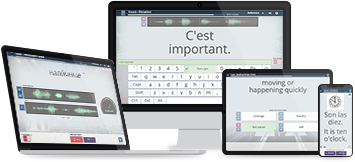Just do it! Giving orders in Danish Posted by Bjørn A. Bojesen on May 31, 2017 in Grammar
 Bring my bag! Call the dog! Sometimes, there’s little time to be høflig (polite), and we need to give somebody a direct ordre (order). In English, we simply use the dictionary form of the verb (go! wait! shut up!) In Danish, it’s almost just as easy to make the bydeform (imperative, literally ”bidding form”). 🙂
Bring my bag! Call the dog! Sometimes, there’s little time to be høflig (polite), and we need to give somebody a direct ordre (order). In English, we simply use the dictionary form of the verb (go! wait! shut up!) In Danish, it’s almost just as easy to make the bydeform (imperative, literally ”bidding form”). 🙂
Do this: Find the right verb in your ordbog (dictionary), remove the final -e, say it!
Now, try it:
- at hjælpe [yelpeh] > Hjælp mig lige med kufferten. (Help me [merely/just] with my suitcase.)
- at nyde (to enjoy) > Nyd ferien! (Enjoy your holiday!)
- at lære (to learn) > Lær dansk, min ven. (Learn Danish, my friend.)
Please note: Double consonants (ll, tt, pp…) are usually shortened when they get that sweet, final spot:
- at scanne (to scan) > Scan to sider. (Scan two pages.)
- at snakke (to chat, to talk) > Snak med mig! (Talk with me!)
Nemt, ikke? (Easy, right?) 🙂
But… What if the dictionary form (AKA the infinitive) doesn’t have a fancy -e extension? Well, then it’s just like you know it from English: no change:
- at se (to see) > Se solen! (Look at the sun!)
- at slå græsset (to cut the lawn) > Slå græsset i morgen! (Cut the lawn tomorrow!)
But… What if the word looks weird without the -e?
Yes, that’s one of the fun details of Danish! 🙂
Imagine ordering somebody to cykle (ride a bike), then klatre (climb) somewhere… Wouldn’t it be impossible to pronounce?
Cykl til huset og klatr op i træet! (Ride your bike to the house and climb up into the tree!)
Surprise – it’s actually official Danish. In the spoken language, I guess, people often say it in other ways, for example using skal (have to, must, shall):
I skal cykle til huset og klatre…
Of course, lovers of krydsogtværs (crossword puzzle) know their smadr! hamr! ændr! (crush! hammer! change!)

Build vocabulary, practice pronunciation, and more with Transparent Language Online. Available anytime, anywhere, on any device.



